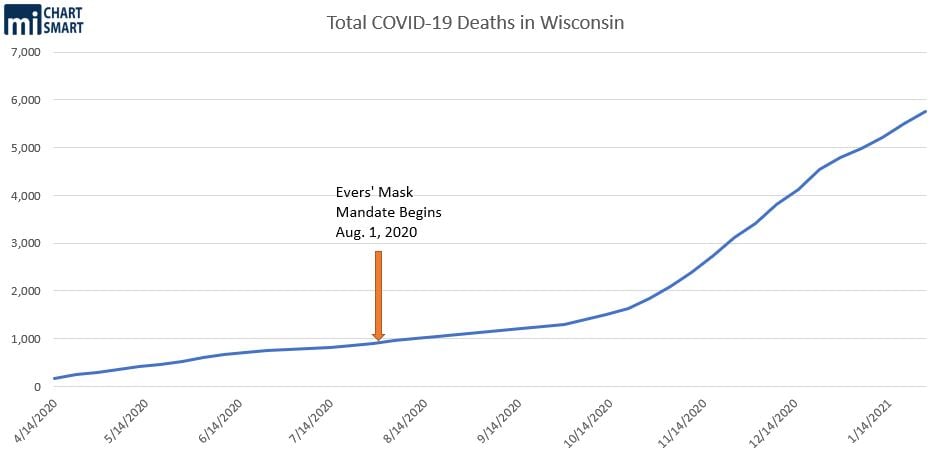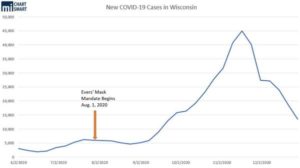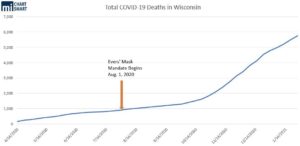
Dan O’Donnell dives into the data to show that Governor Evers’ mask mandate hasn’t been effective in either stopping the spread of COVID-19 or preventing deaths from it.
January 29, 2021
Perspective by Dan O’Donnell
To believe liberals is to believe that Wisconsin narrowly averted a catastrophe Thursday when the State Assembly decided at the last minute to delay a vote to end Governor Evers’ statewide mask mandate. To believe conservatives is to believe that Assembly Speaker Robin Vos once again sold out the movement to help his big business cronies.
Believe neither.
Vos did indeed cancel a vote on the Senate’s resolution to end the public health emergency Governor Evers declared earlier this month (a vote that would also end the state’s mask mandate, which was issued using the Governor’s emergency powers), but it is likely that this is only a temporary delay.
Multiple sources indicated Thursday night that the Assembly would vote next week after seeking a delay to ask the Legislative Fiscal Bureau to determine whether the Senate’s resolution as written would inadvertently give Evers even greater power.
“It’s just a procedural hurdle that some representatives wanted to make sure we wouldn’t trip over,” said one source.
“It was only a temporary delay,” another said. “We’re going to vote next week and we’re going to end [the mask mandate].”
Enough members were apparently concerned with the possibility that the Senate’s resolution was not clearly written enough to preclude the possibility of Evers using it to impose even more draconian measures that they indicated that they wouldn’t vote for the resolution on Thursday.
Vos seemed to confirm this to reporters earlier in the day, saying that “our job is to guarantee when we pass legislation, we know what the ramifications are. Unfortunately, our Senate colleagues passed it, they didn’t necessarily do the same due diligence.”
Once that is done, the Assembly will vote on ending the public health emergency and almost certainly vote to end it.
While this will end the statewide mask mandate, it will most assuredly not, as Democratic Senator Chris Larson rather hilariously claimed, “literally kill our neighbors.” In fact, the data suggests the exact opposite.
What impact did the mask mandate have on #COVID19 cases and deaths in Wisconsin? Look at the charts and judge for yourself. (Remember: it takes 2-4 weeks for any new policy to begin impacting the data). #WIright pic.twitter.com/qogMxDfKHV
— MacIver Institute (@MacIverWisc) January 29, 2021
According to the Wisconsin Department of Health Services (DHS), there were a total of 934 COVID-19 related deaths from March 15th (the first day DHS began tracking deaths) through July 31st (the day before Evers’ mask mandate went into effect). In those 139 days, there were an average of 6.7 deaths per day.
In the first 139 days of the mask mandate (August 1st through December 17th) there were a total of 3,321 deaths for an average of 23.9 deaths per day.
This, of course, is not an apples-to-apples comparison. The spread of flu-like illnesses typically slows in the late spring and summer months and then picks up again in the fall, but to illustrate what a non-existent impact the mask mandate has had on preventing COVID-related deaths, the week before the mandate went into effect there were 56 COVID deaths. The week after, there were 49.
A better comparison, though, would be the last week of June—before national retailers and restaurant chains began implementing mask requirements throughout July—and the third week of August, ensuring that those who had become infected had become infected during the mask mandate.
In the last week of June, there were 34 deaths. In the third week of August, there were 43 deaths.
In fact, until the sudden spike in COVID deaths in late September and early October (which coincided with the normal start of cold and flu season), there was no discernible change in the number of COVID deaths per day over the summer, indicating that the mask mandate did nothing to lower the number of deaths.
In terms of slowing or stopping the spread of COVID-19, too, it seems as if the mask mandate did not live up to Governor Evers’ promises. In the 139 days from March 15th (when DHS first started tracking new COVID cases) to July 31st (the day before the mask mandate went into effect), there were 52,940 total cases and an average of 380.8 per day. In the first 139 days after the mask mandate took effect, there were 395,501 new cases for an average of 2,845.3 per day.
Again, the onset of the normal cold and flu season with the colder fall months is the far more likely culprit for the massive rise in COVID cases, but even a comparison of the weeks immediately before and after the mandate went into effect shows there was no discernible difference.
In the last week of June (again, the final week before widespread mask requirements began appearing in the private sector), there were 3,328 new cases for an average of 475.4 per day. In the third week of August (again, the first week in which all new cases would have been transmitted while all Wisconsinites were required to wear masks in public), there were 4,832 new cases for an average of 690.3 per day.
If the goals were to stop the spread of COVID and to keep it from killing people, then it appears that Wisconsin’s mask mandate has failed at both. Total deaths and total new cases both rose precipitously in the months immediately following Governor Evers’ order, and even taking the normal seasonal spike in fall out of the equation, it appears that Wisconsin may have actually been battling COVID-19 more effectively before the mandate went into effect.
Now it appears that that mandate will be repealed next week, provided, of course, that Assembly Republicans are able to cross all their procedural Ts and dot all their parliamentary Is. There will be undoubtedly some representatives who fear blowback, but the data doesn’t lie, and it is clear that worries over Wisconsin without a mask mandate are dramatically overblown.







